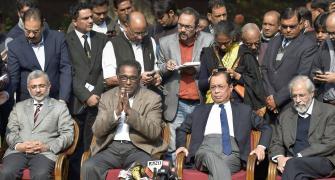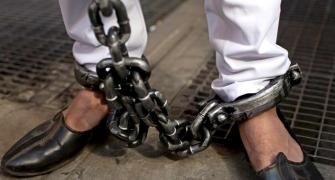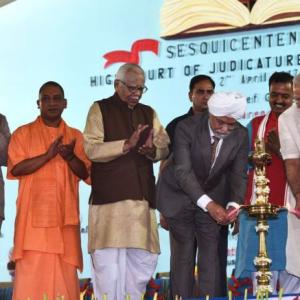The Supreme Court of India became 'lions under the throne' when Jawaharlal Nehru brought in the Fourth Amendment in 1955, says T C A Srinivasa Raghavan.
Illustration: Dominic Xavier/Rediff.com

Judges have been making news for centuries, for good, bad, right and wrong reasons. They wield enormous power because they decide what is ok and what is not in what governments do.
In that sense they are the real bosses of any country.
The first book I read about a judge was in the late 1960s. It was called Courtroom by Quentin Reynolds about an American judge called Samuel Leibowitz. I don't know why I read it. It must have been a long and boring summer.
Since then I have read many books about judges and what they do. One of the best books that I have read is about the US Supreme Court. It is called Nine Scorpions in a Bottle by Max Lerner.
That term was coined by Oliver Wendell Holmes. He was referring to the catfights that went on between the judges. It happens everywhere.
There is another about an English judge called Edward Coke. In the early 17th century he told James I of England who thought he had a 'divine right to rule' to take a walk. He said the king and parliament were subject to the test of 'reason and common right'.
He didn't think, as Francis Bacon did, that judges must be 'lions under the throne' -- growl but not bite when the State misbehaves with the citizens.
He believed the relationship had to be something like the one suggested for the Reserve Bank of India and the government in 1931 -- that of a 'Hindoo wife' who advises but does not interfere.
The tussle between the sovereign and the judiciary has been going on since then. As with all institutions, the sovereign appoints the judges who then defy it.
The Indian Supreme Court became 'lions under the throne' when Jawaharlal Nehru brought in the Fourth Amendment in 1955 to show the judiciary its place as far as ruling on property rights is concerned. (Just imagine what would happen if the Bharatiya Janata Party tried anything like it.)
In 1971, the Supreme Court re-asserted itself. It told Indira Gandhi to be a good girl and not be a nuisance to Indian democracy. She not only refused, but also struck back by appointing loyalist judges.
There was even talk of a 'committed judiciary'. Again imagine what would happen if the BJP tried anything like it.
In 1992, the Court retaliated and asked the government to lay off appointments.
A few years ago, the government again tried, this time via Parliament, to wrest back control over appointments.
The judges simply struck down the new law. That is how powerful they are.
Although the battle between the government and the judiciary has been going on for centuries, in India it is of more recent origin.
The best account of the Indian Supreme Court's early years -- it began in 1937 as the Federal Court -- has just been published.
Believe it or not, it is a PhD thesis of an American scholar called George H Gadbois Jr. He wrote it back in the 1970s and it lay unpublished on his shelf since then.
But his interest in the Indian judiciary and Indian Constitutional law continued. Now Vikram Raghavan and Vasujith Ram have retrieved it, written a superb introduction to it and persuaded Oxford University Press to publish it. For Rs 800, it is a real steal.
Gadbois is not around to see it -- he died last year -- because he had been very tenacious in his quest. At one point, he had even been denied entry into India because the government thought he was a CIA agent!
For anyone interested in the Indian judiciary and the Supreme Court it is a must read. He would have been aghast at the infighting that is going on now.
The book shows just how far Nehru was willing to go in echoing Henry II: 'Will no one rid me of this meddlesome priest'?
Basically, says Gadbois, the problem lies with the power of judicial review. The judiciary has invested it to mean absolute judicial supremacy. The government begs to differ.
Gadbois's answer, written in 1962, is below:
'Whereas decisions of the Federal Court which embarrassed the British won the acclaim of the Indian nationalist leaders... decisions of the Supreme Court which have thwarted the government have produced the opposite effect. The ease with which the Constitution may be amended... indicates that while the Court's jurisdiction is extraordinarily wide, its ultimate power is limited... the Constitution means what the Congress party says it means... judicial review has certainly not meant judicial '
Amen.











